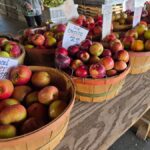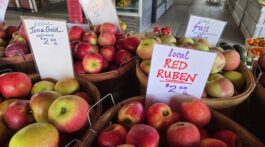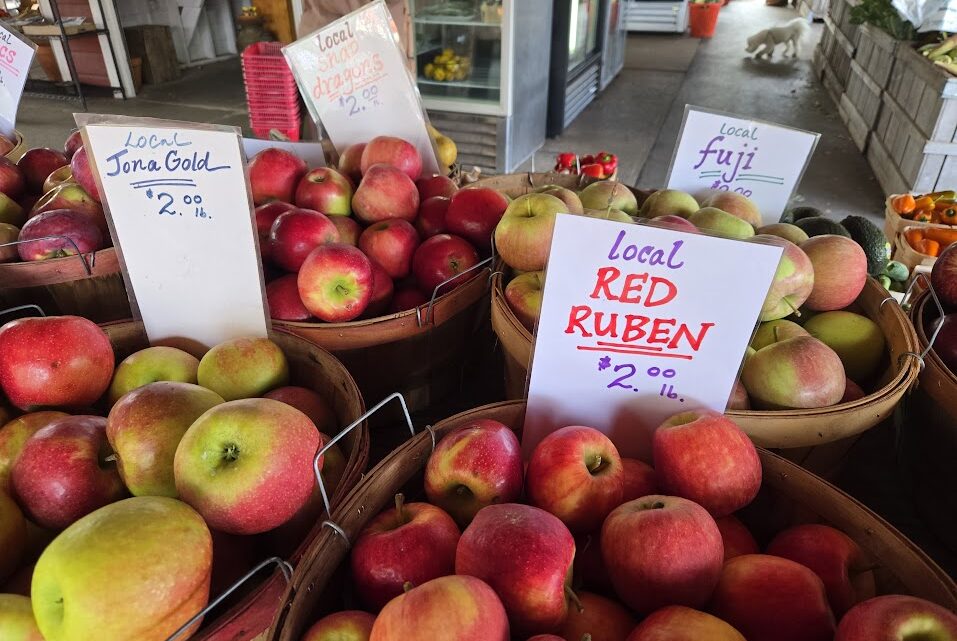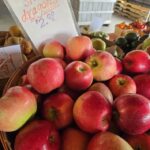Apples are the season’s crowing glory
By Frank Whitman
 Fall has lots going for it – colorful foliage, bright blue sky, and crisp cool breezes – but most importantly, apples are in season. The weather is great and farmstands and markets are packed with bounty. Apples, for me, are the season’s crowning glory – equal to asparagus in Spring, tomatoes in July and peaches in August.
Fall has lots going for it – colorful foliage, bright blue sky, and crisp cool breezes – but most importantly, apples are in season. The weather is great and farmstands and markets are packed with bounty. Apples, for me, are the season’s crowning glory – equal to asparagus in Spring, tomatoes in July and peaches in August.
An ancient fruit (remember Adam and Eve?), apples have spread around the world, growing in a stunning array of colors and flavors across all temperate zones. New York farmers alone grow more than 250 varieties according to The New York Apple Association, although you might see only 20 or 30 in markets.
Apples are that rare seasonal product that don’t get featured on restaurant menus – farm to table or otherwise. Yes, there will be a bump in the number of apple desserts but not many appearances on the main menu. Since apples can be stored and are available year-round, their seasonality is suspect. But for me, a fresh-picked apple tops a cold-storaged or imported one any day.
There should be an award for naming apples, in fact I’ll bet there is. The evocative names read like poetry. Early versions were named after people or places: McIntosh named after its discoverer John McIntosh, or Cortland named after the Finger Lakes County in New York where it was developed. Other names try (and often succeed) in evoking the pleasure of the eating experience: Winesap, Honeycrisp, SnapDragon, Evercrisp and the obvious Red or Golden Delicious.
Jim Story, head of the family at Story Farms in Catskill, NY, had trouble choosing when I asked for his favorite apple. He finally recommended a locally-grown SnapDragon. Medium-sized with cheerful red cheeks, the SnapDragons were crisp and snappy with a mild appley flavor and long finish.
New varieties of apples are discovered or developed. Trees do not grow true-to-type from seeds. Sometimes there is the happy coincidence of a good apple discovered in nature or sometimes a successful new apple comes from cross pollination. New varieties are then propagated through the laborious process of grafting, where wood from the desired tree is joined with a strong rootstock to produce each new plant. It takes a while to develop enough trees for a commercial orchard.
Apple, which should be the flagship flavor of fall, has been overtaken by the ubiquitous presence of “pumpkin spice,” that irresistible mix of cinnamon, nutmeg, ginger, and cloves. Named after the flavors in pumpkin pie, I don’t know why it’s not called Apple Pie Spice – the same flavors are there too.
Apple Pie holds a special place in our culture – as it should. (As American as …) Double-crust fruit pie is a uniquely American creation. In early America, apple was among the most widely baked and popular pies – probably because of the ubiquity of apples.
In the heyday of the family farm, there were usually a few apple trees as part of the mix. Some produced firm, bitter, tannic apples that were fermented into hard cider. Others, seasoned with sugar and spice, were good for baking pies, crumbles, crisps and pandowdys. Apples could be stored in root-cellar barrels or dried as a staple food for the family. (But don’t let that bad apple spoil the barrel!)
At this time of year I’m always encouraging Marsha to make her family-recipe apple crisp. It’s irresistible. I’m looking for an occasion to bake an apple galette from Jacques Pepin and Julia Child’s collaborative cookbook, Cooking at Home. It’s my annual ritual.
More recently, apples were developed as an eating fruit. They come in many styles: firm, soft, tart, and sweet in a wide range of reds and greens. If you ask the farmer at the Woodland Farm stand for his favorite baking apple, he’ll fill the bag with a mix of fruit that will combine flavor, texture and complexity in your favorite apple bake. Woodland, in Glastonbury, sells at eight farmers markets around Connecticut.
 While restaurants largely ignore seasonal apples, bakeries are a different story. Pie shops, like Michele’s Pies in Norwalk or The Whistle Stop Bakery in Ridgefield, are loaded with apple pies at this time of year. Michele’s has 6 flavors of apple pie in regular rotation as does the Whistle Stop.
While restaurants largely ignore seasonal apples, bakeries are a different story. Pie shops, like Michele’s Pies in Norwalk or The Whistle Stop Bakery in Ridgefield, are loaded with apple pies at this time of year. Michele’s has 6 flavors of apple pie in regular rotation as does the Whistle Stop.
If you’d rather have your apples straight up instead of baked in a dessert, put some shine on them with cheese. The folks at the Fairfield and Greenwich Cheese Company have put together some pairings of their favorite cheeses with apples. Shelburne Farms Cheddar with Honeycrisp, Brie with Pink Lady, and Gouda with Cortland are some of their ideas. Visit one of their shops for more ways to cheese up your favorite apple.
Remember the old saying, An apple a day …, and get them fresh and local while the season lasts.















No Comment